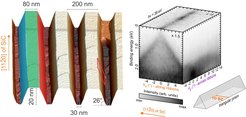Structured expitaxial graphene

Graphene is expected to be a very versatile material in electronic devices due to its high charge carrier mobility. However, a prerequisite for the usage of graphene e.g. in logic devices is the presence of a band gap, which is absent in large epitaxial layers of graphene. Up to date a number of possible approaches have been proposed to induce a band gap, e.g. by chemical doping or inducing spin-orbit interaction. One of the most promising routes towards introducing a band gap of graphene is confining graphene’s charge carriers into one-dimensional stripes, called graphene nanoribbons (GNRs). Due to its epitaxial single crystalline growth of graphene on SiC it is expected that the termination of the graphene edges in GNRs can be well controlled to the zig-zag or armchair geometry. Among which the latter plays a major role since graphene with armchair like atomic configuration at the edges is predicted to be semiconducting. The preparation of GNRs from extended graphene layers by means of lithography however, induces a huge amount of defects and as thus will not result in well-controlled semiconducting GNRs. In an early work (Stöhr 2017) we were able to grow graphene nanoribbons on a previously structured SiC (0001) substrate. During graphene growth, the sidewalls of the nanostructured SiC relax leading to facets on which ribbon-like graphene is present.
Recently, by an improved growth scheme, we were able to grow armchair nanoribbons, which exhibit a width dependent band gap (Karakachian 2020). ARPES desmonstrated an ideal one-dimensional electronic behaviour showing well-resolved subbands, dispersing and non-dispersing along and across the ribbons, respectively. Also the growth of zigzag graphene nanoribbons revealing a surface state at the position where the lower edge merges into the SiC was demonstrated recently (Nhung Nguyen 2021).
Publications:
- T. T. Nhung Nguyen, N. de Vries, H. Karakachian, M. Gruschwitz, H. Aprojanz, A. A. Zakharov, C. Polley, T. Balasubramanian, U. Starke, C. F. J. Flipse, C. Tegenkamp, Nano Lett. 21, 2876-2882 (2021). Topological surface state in epitaxial zigzag graphene nanoribbons.
- H. Karakachian, T. T. Nhung Nyuyen, J. Aprojanz, A. A. Zakharov, R. Yakimova, P. Rosenzweig, C. M. Polley, T. Balasubramanian, C. Tegenkamp, S. R. Power, U. Starke, Nat. Commun. 11, 6380 (2020). One-dimensional confinement and width-dependent bandgap formation in epitaxial graphene nanoribbons.
- A. Stöhr, J. Baringhaus, J. Aprojanz, S. Link, C. Tegenkamp, Y. Niu, A. A. Zakharov, C. Chen, J. Avila, M. C. Asensio, and U. Starke, Ann. Phys. 529, 1700052 (2017). Graphene ribbon growth on structured silicon carbide.
- J. Baringhaus, A. Stöhr, S. Forti, U. Starke, and C. Tegenkamp, Sci. Rep. 5, 9955 (2015). Ballistic bipolar junctions in chemically gated graphene ribbons.
- J. Baringhaus, A. Stöhr, S. Forti, S. A. Krasnikov, A. A. Zakharov, U. Starke, and C. Tegenkamp, Appl. Phys. Lett., 104, 261602 (2014). Bipolar gating of epitaxial graphene by intercalation of Ge.
